Is it Time for Zelda to Reintroduce Magic?
Posted on March 11 2013 by Legacy Staff
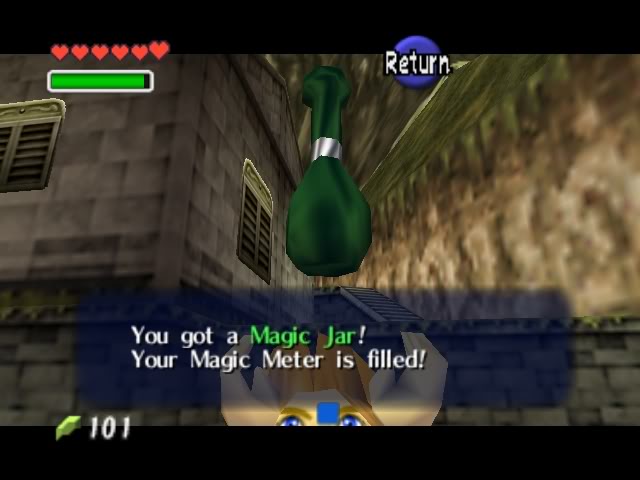
Magic has had quite an interesting relationship with the Legend of Zelda series throughout its history. While elements of magic have always been at least thematically present in Zelda games, magic itself has not always been a part of Link’s available weaponry. Link has only used magic as a means of offense in The Adventure of Link, A Link to the Past, Ocarina of Time, Majora’s Mask, and The Wind Waker. Its implementation within the different games has been fickle to say the least, and its usability has seen several alterations. The success of magic as a gameplay element has also been varied, which may be a reason for its recent absence.
The Magic Meter as well as magical spells and items have served a number of purposes to Link throughout his adventures. Magic in all of the Zelda games in which it has been featured has been given a dedicated meter that keeps track of how much has been used, and how much is remaining. By using certain magic items or spells, the meter will decrease, depending on how powerful the magic is. The Magic Meter can be replenished by picking up magic jars in the field or by drinking a Green Potion. Primarily, magic has been used to solve puzzles, defeat enemies, and provide the player with additional defenses.
What makes the Magic Meter interesting is that since it decreases with every usage of magic, it gives the player an additional resource to keep track of. The tactical management of deciding when to use certain abilities creates an additional layer of depth that singular items cannot provide. While certain items like the Bow are limited by their ammo capacity, magic differs in the sense that multiple skills are tied to one limited supply.
Despite the unique qualities that magic can provide, it has not been seen in a new Zelda game since The Wind Waker ten years ago. It should be noted, though, that it was originally intended to be included in Twilight Princess. This suggests that with the recent games, it has been a deliberate decision to remove the Magic Meter from the core gameplay. Why is that? To decipher that, it would be beneficial to analyze what about the Magic Meter has worked in the past and what has not. Based on that, it would be easier to tell what would work best if magic was to be implemented into Zelda Wii U.
The Adventure of Link
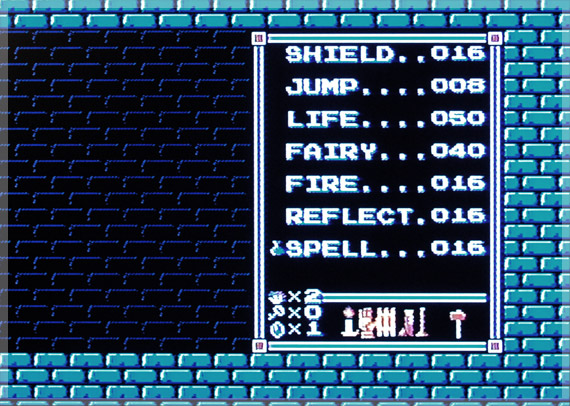
Zelda II: The Adventure of Link was the first game in the series to utilize magic as a gameplay element. It also features magic much more prominently than any other Zelda game. Although Zelda II plays dramatically differently than the rest of the Zelda games, that does not mean we should exclude it from being a source of inspiration.
The Adventure of Link takes a vastly different approach on its gameplay than its predecessor, and not just because of its side-scrolling nature. Games in the Legend of Zelda series are known for having combat that emphasizes a symbiotic relationship between the sword and an array of secondary weapons. Zelda II takes a different approach to this idea by denying Link of an attainable inventory, and he instead employs him with magical spells as secondary weapons. This was definitely a unique approach to a Zelda title, but it was not appreciated as much as it should have been because the game differs so drastically from the rest of the Zelda franchise.
Barring perhaps a single exception, the spells all have consistently practical purposes. There are defensive spells, offensive spells, and three other “action” spells, which have more unique functionalities.
Among the defensive spells are Shield, which doubles the players defenses, Life, which restores health, and Reflect, which deflects magic beams from enemies. Each spell is useful in keeping the player alive, which comes in handy in such a difficult game.
The offensive oriented spells are Fire and Lightning, which summon a fireball and lightning, respectively, to attack enemies. The player needs to decide when is the best time to use them in order to both conserve as much magic as possible and to defeat enemies as efficiently as they can. Spell could also be considered an offensive spell, as it turns enemies into Bots (the little slime creatures).
The ability Fairy is extremely interesting to me. It has many different emergent strategies associated with it, such as avoiding enemies and flying to higher locations. Most interestingly, just like in the original Zelda where you can buy keys, you can fly through locked doors as the fairy in Zelda II. This provides an alternative solution for those who are less puzzle or exploration savvy, but comes at the cost of reducing your limited magic bar.
The last spell, however, is less interesting and actually helps define my main gripe with magic in the Zelda series. The Jump spell, while it theoretically could be used strategically, is not a very viable tool. It merely consumes magic to complete required tasks. It is exceedingly frustrating to be in a situation where you know that you have to jump to reach a higher platform to move on, but you cannot do it because you don’t have enough magic. I will probably constantly repeat this, I apologize in advance, but arbitrary limits should not be imposed on tasks that are necessary to progress through a game. Jump should have been made to be more viable in multiple situations, and high platforms should have been either removed or dedicated to discovering optional secrets. They also could have made high jumping a skill that did not require magic, just like the upward and downward thrust attacks.
Despite a few shortcomings, Zelda II had a very well designed, well implemented system of magic, most likely because it was a deliberate focus of the game’s design.
A Link to the Past
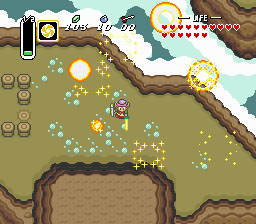
Many of the ideas that were presented in Zelda II in regards to magic were translated in one way or another into A Link to the Past. Although this entry in the series returned to a style of gameplay similar to the original Legend of Zelda, the magic concepts introduced in Zelda II were altered to fit within this type of game. The main difference is that the Magic Meter was tied to the usage of certain items, rather than its own set of abilities. This was an effective method for the most part, although it did come with its share of inherent flaws.
A Link to the Past shared the problem of having some magic items used to solve mandatory puzzles, although, thankfully, none of them were used exclusively for this purpose. It was a clever design choice that in some situations, there were ways around using those items. For example, although there were many locales enveloped in darkness throughout the game, you did not necessarily need to light candles with your Lamp in order to progress. There were defects though, like the fact that Link needs two of the Medallions in order to open two of the game’s dungeons, and they require magic to open.
One of the parts that comes to mind as significantly aggravating was facing the boss Trinexx, which required the usage of the Ice and Fire Rods to win. I ran out of magic a few times facing the boss before I was able to defeat it. What’s worse is that after losing, you are warped to the beginning of the dungeon and must grind to find more magic before you even think about facing the boss again. I will repeat, do not create such limits on tasks that I need to execute in order to progress. This is not the way that difficulty should be implemented. After discovering a way to accomplish a task, the execution of the task is what should be challenging. Being physically unable to accomplish a task you know how to execute is not an example of difficulty, but an example of unfairness. This boss fight could have been fixed easily by allowing alternate methods of defeating it, even if they were less effective.
Some of the items were very innovative and very useful, though, and what was very cool is that some of them were entirely optional to acquire. The Magic Cape and the Cane of Byrna were two very cool hidden items that were very powerful, yet consumed a lot of magic. Items like these make a system of magic very interesting and thoughtful.
Ocarina of Time
The practical usage of the Magic Meter saw a significant decrease in Ocarina of Time. Most of the items that consumed magic were either essentially useless in combat or were used to solve puzzles. There were some notable exceptions, though.
Of the three magical spells, only one of them really justifies the use of magic. Nayru’s Love creates a shield around Link for a short amount of time that prevents him from taking damage, in exchange for a large amount of magic. While this is a good idea in theory, I don’t know of many people who actually used it. On top of only being available towards the end of the game, there are not many situations that make the player feel in danger enough to use it. Besides Nayru’s Love, two other spells exist in the forms of Din’s Fire and Farore’s Wind. Farore’s Wind can be incredibly useful in traversing dungeons more quickly and efficiently, but there is no reason that it should cost Magic Power. Din’s Fire can be useful in some situations, but it is mainly used to mandatorily light torches, and I’ve already mentioned my disdain for such things.
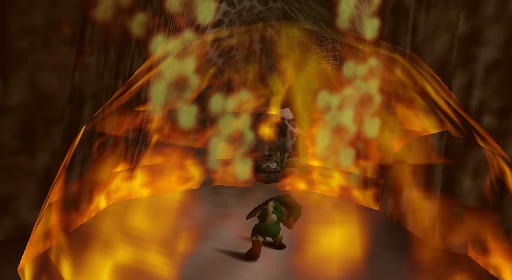
The game also introduces the Lens of Truth, which goes both ways for me in terms of successful functionality. On the one hand, it is a very cool concept to view hidden objects in the environment by using the item in exchange for magic. On the other hand, the player will have no idea what to do without its help. Unlimited usage of the Lens of Truth would have been overpowered and would have made puzzles much easier, but conversely if Link has no magic left, he will be entirely stuck. It’s hard to say what would have made this more balanced, but at the very least there should have been more environmental cues leading the player to the solution without the Lens of Truth, so they would not be completely lost without it available.
New to Ocarina of Time is the charged spin attack, which is acquired along with the Magic Meter. This was a very cool, almost natural evolution to the sword beam of previous games, but did come with its share of problems. For one, you could bypass using magic entirely with this attack by just spinning the control stick and pressing B. Admittedly, you will not get the full range of the attack this way, but it is impractical to wait for a full charge in most combat situations anyways.
Finally, the game introduced the elemental arrows. Both the Fire and Ice Arrows are technically optional, which is nice, but neither are ever all that useful. The fact that they are never needed in order to progress is nice, though (that is if you have Din’s Fire). In exchange for the magic that they cost, they boast greater power and different effects than regular arrows. Most importantly though, they just look pretty awesome. Overall, the added bonuses of these arrows very rarely justify their use, and most people choose not to use them due to inefficiency and lack of necessity. The Light Arrows barely even see opportunity for usage since they are introduced so late in the game. They are a very cool item, though, despite the fact they are required for the first phase of the Ganondorf battle, even if you’ve run out of magic. Granted there were jars on the floor below to replenish your magic, it would still be obnoxious to have to interrupt your fight to go get that.
Majora’s Mask
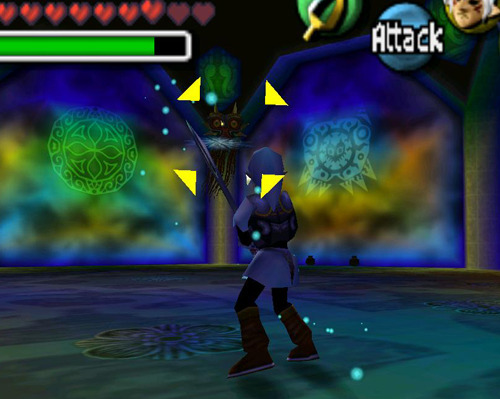
Majora’s Mask utilizes essentially the same magic system of Ocarina of Time, so there is less to note about it. However, the game managed to expand on it slightly, but also took a few steps backward. Primarily, the Fire, Ice, and Light Arrows saw more usage as puzzle-solvers, much to my dismay, but were also a bit more useful in regular combat. Some masks used magic well, though. The magic shield used by Zora Link was a good concept, although due to its power, it should have drained magic more quickly. The Giant’s Mask was a smart, alternative way to fight the boss Twinmold, due to its power but quick drainage of magic power. The Fierce Deity’s Mask drains magic as he continues to attack, which was also very cool, and a great reward for completionists. One thing that Majora’s Mask introduced that should NEVER be repeated, though, is Chateau Romani. Despite being moderately expensive, this is a small price to pay for being essentially invincible in multiple situations. This meant the nearly unlimited usage of one-hit-kill Light Arrows and Fierce Deity Link, which is almost indisputably overpowered.
The Wind Waker
Excuse the extremity, but The Wind Waker took everything that was cool about magic and completely threw it out of the window. Other than the Deku Leaf, the game did not add anything new to the realm of usable magic in the Zelda universe, and merely borrowed concepts from Ocarina of Time. There are five items in the game that use magic, and, uninterestingly, three of them are different types of arrows.
Upon obtaining the Deku Leaf, the usage of the Magic Meter almost makes sense. One of the two functions of the item is a flotation device that is used during certain execution puzzles. It’s reasonable to have some sort of limitation on the time you can remain afloat so that there is an actual challenge to these puzzles, however, there is no reason that a Magic Meter should be this limitation. For one, a giant leaf just does not seem like a magical entity in any sense. It simply would have made more sense to relegate the item’s gliding time limit to some other meter that applied to the Deku Leaf alone. It also would have kept this limit constant throughout the game, regardless of increases to the Magic Meter.
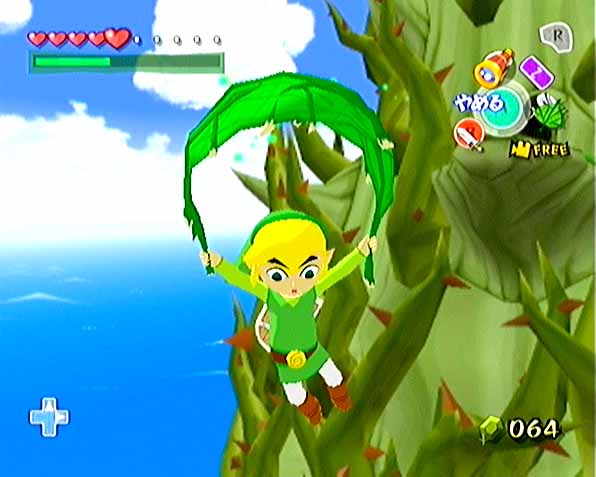
While having elemental arrows consume magic power is not a new idea, it is not improved or made any more sensical in this game than it was before. The Fire and Ice arrows only serve to gain access to a couple of islands in the game, and then they become essentially useless. Sure, they can be used in battle, but there’s no real reason to since they will not really help you be any more effective at defeating enemies. Again, it makes sense to have some sort of limit on a more powerful item, but this is not the way to go about it. The Light Arrows also have the same problem as in Ocarina of Time where they are obtained at the end of the game, and are mainly used mandatorily to defeat the final bosses.
Another borrowed concept from Ocarina of Time is Magic Armor. After completing a lengthy side quest, you are given this item which is almost identical in function to Nayru’s Love.
It almost seems like Nintendo implemented magic for the sake of it in The Wind Waker, and just because it was present in previous Zelda games. It is an entirely tacked on feature and does not improve the gameplay in any way. Based on this, it makes sense that they would remove the magic meter from Twilight Princess. The two games have almost the same amount of thematically “magical” items in their inventories, but by the time of Twilight Princess the developers seemed to realize that does not mean that tacking on a Magic Meter would be wise. They were smart and gave specific items, like the Lantern, their own limitations (which is exactly what the Deku Leaf should have done!).
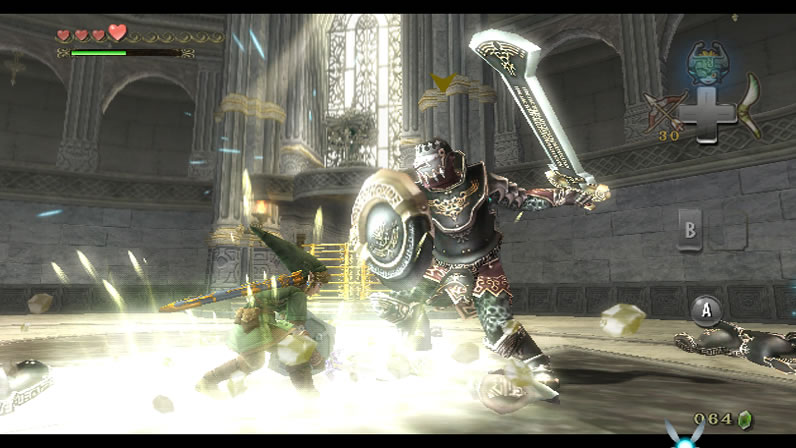
Summary
In general, magic’s implementation became worse as the series progressed. It became less of an actively developed game design idea, and more of a thematic add-on to the games. Based on how its been implemented in past Zelda games, I think its safe to say that magic works best when it plays an integral role aiding Link’s survival. It works well when it gives an overarching limit to your most powerful set of moves so that you cannot constantly abuse them, but come in handy when facing particularly difficult situations. There is more incentive to use magic in more difficult games because your standard set of moves may not save you from death. Magic, in its best implementation, is a tool to be used sparingly and tactically for the best results.
Magic does not see its potential realized in the best way when it is used primarily by puzzle items. Imposing a limit on a tool that is necessary to overcome a challenge is nothing more than frustrating. In these instances, your resource to solve the puzzle should be unlimited, and the challenge should come solely from discovering the solution and executing it.
So how should magic be incorporated into Zelda Wii U?
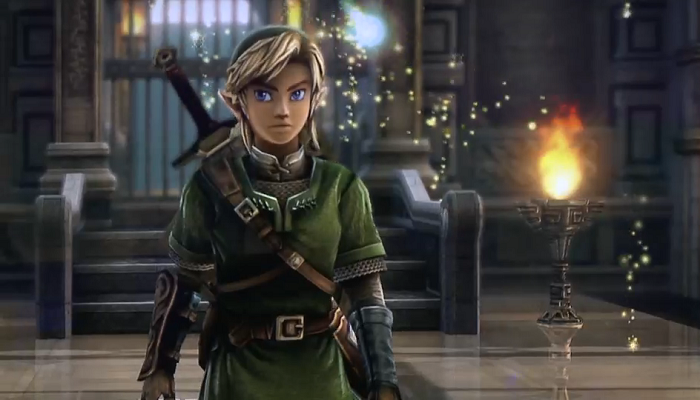
I believe that, if implemented properly, the next Zelda game could benefit greatly from a reintroduction of the Magic Meter. It would mostly incorporate elements from Zelda II and A Link to the Past where it seemed to have a clearer design goal, although some of the ideas introduced in Ocarina of Time and Majora’s Mask could be included.
The sword beam should be included again, but in a slightly different vein. Borrowed from Ocarina of Time‘s charged spin attack, as well as Fierce Deity Link’s sword beams from Majora’s Mask, the sword beam would require magic to use. Summoning the sword beam should be as instant as it was in the end of Skyward Sword’s Hero Mode in order to keep it useful and practical, but Zelda Wii U would have it limited due to the magic consumption. In games like The Legend of Zelda and A Link to the Past, it never really made much sense to only have this powerful, ranged weapon when at full health, so limiting the usage of this technique through magic would lead to a balanced middle ground between the different approaches.
Enemies and bosses should be designed so that magic is never necessary to defeat them, but it is much more effective in certain situations so that its use is justifiable. Certain enemies can be weaker to certain magic attacks, but you should be able to defeat them without it so you are never completely stuck. This way, running out of magic makes situations more challenging, but not complete dead ends.
Magic should never be necessary to solve mandatory puzzles. Magic can definitely be used for puzzle-solving, but it should be dedicated to optional puzzles and secrets. With this implemented, if you come across a puzzle that requires magic, but you have run out, you can continue to progress and you can simply remember to come back to it later.
Since magic is such a powerful resource, it should be more difficult to acquire. Enemies and jars dropping magic should not be too frequent, as a constant replenishment of your most effective tools would become quickly overpowered. The most reliable form of magic recovery would be carrying Green Potions.
The game should also remove items that rely on Magic for ammunition, except for one new item; a Spellbook. The Spellbook would be similar in concept to Link’s list of spells in Zelda II, but applied to the current Zelda formula. Looking at the previous Zelda games, magic has appeared to be most focused and tightly designed when it has been its own entity. The spells included would move away from having entirely puzzle-based purposes, and primarily include abilities that will aid in Link’s survival. There could be moves similar to those like we’ve seen in past Zelda games, only they would not be tied to separate items. As always, the more powerful the spell, the more magic consumed.
Just a few examples of what could be done:
- Fire Blade: A spell that engulfs the sword in magical fire after charging a sword beam. Enemies caught on fire will slowly receive damage. Can also be used for light. (Similar to Fire Arrows/Din’s Fire)
- Ice Blade: A spell that engulfs the sword in magical ice after charging a sword beam. Frozen enemies cannot attack until thawed. (Similar to Ice Arrows)
- Wind: Blows a powerful gust of wind all around Link that will push most enemies back and down to the ground, leaving them temporarily open for an Ending Blow.
- Lightning: Strikes all on screen enemies lightning for weak damage, and momentarily stuns them. (Like in Zelda II)
- Invisibility: Briefly makes Link transparent, making it impossible for most enemies to see Link. Enemies can still deduce where Link is based on his movements. (Like the Magic Cape from A Link to the Past)
- Life: Restores some of Link’s health. (Exactly like from Zelda II)
- Shield: Reduces the damage that Link takes from enemies for a short period of time. (Exactly like from Zelda II)
These are just a few ideas, but the possibilities are endless for an arsenal of super moves for Link to utilize. But what do you think? Should magic be included in the next Zelda game? Have you liked how the past Zelda games have incorporated magic or do you think it should remain absent in future titles? Leave your thoughts in the comments!



